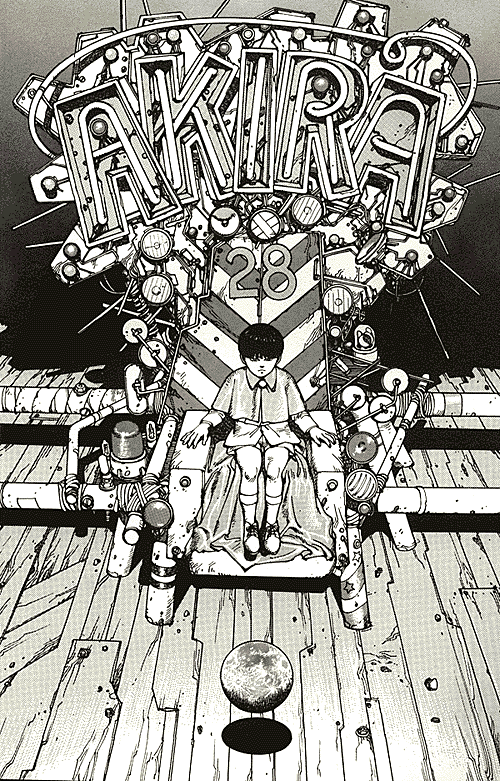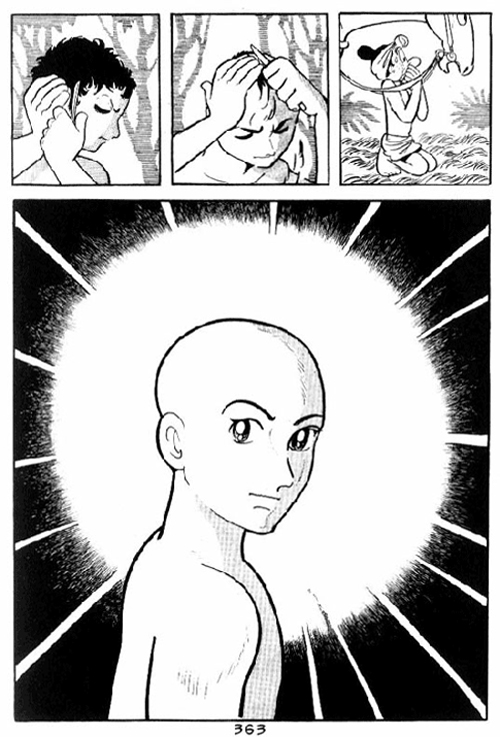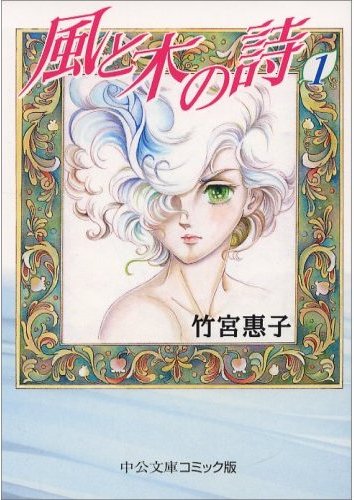 Though manga has been a fixture of the American comics scene since the mid-1980s, it wasn’t until the anime boom of the following decade that publishers began to get savvier about what they were licensing and how they were packaging it. The shift away from manly-man titles towards teen-friendly material, and from floppy to trade paperback, had a big impact on who bought manga; once found only in comic book stores, manga now appeared in big chains like Borders and Walmart where young fans of the Dragonball and Sailor Moon TV shows could find it. By the mid-2000s, manga sales were robust enough to crack the USA Today bestseller list, inspiring more companies to jump into the licensing game.
Though manga has been a fixture of the American comics scene since the mid-1980s, it wasn’t until the anime boom of the following decade that publishers began to get savvier about what they were licensing and how they were packaging it. The shift away from manly-man titles towards teen-friendly material, and from floppy to trade paperback, had a big impact on who bought manga; once found only in comic book stores, manga now appeared in big chains like Borders and Walmart where young fans of the Dragonball and Sailor Moon TV shows could find it. By the mid-2000s, manga sales were robust enough to crack the USA Today bestseller list, inspiring more companies to jump into the licensing game.
The manga gold rush came to a crashing halt in 2008. A confluence of forces — economic recession, abundant scanlations, rising paper costs, teen fickleness — forced all but the biggest and best-financed publishers to cease operations.
It comes as little surprise, then, that many of the manga on the Best Comics list are ones that outlived the market’s dramatic boom-and-bust cycle. Lone Wolf and Cub, which ranked 48th in the Best Comics Poll, made its Stateside debut in 1987, just one year before Marvel Comics began releasing AKIRA (#40) and VIZ began publishing Nausicaa of the Valley of the Wind (#73). Rumiko Takahashi’s beloved romantic comedy Maison Ikkoku (#73) is another long-lived series, going through three editions since 1993, when VIZ first acquired the North American rights.
Equally important is the role of the American comics establishment in anointing certain manga as masterpieces. AKIRA, Buddha (#71), Lone Wolf and Cub, and 20th Century Boys (#96) are all Eisner winners, while Pluto (#48), A Drunken Dream & Other Stories (#96), The Walking Man (#73), and Yotsuba&! (#73) were past nominees. The American industry hasn’t neglected creators, either; Comic-Con International has bestowed its Inkpot Award on some of the list’s best-known contributors, including Osamu Tezuka, Rumiko Takahashi, and Hayao Miyazaki.
 But perhaps the most striking thing about the top vote-getters is how many of their creators embody the Great Man stereotype. Consider Osamu Tezuka, whose Buddha and Phoenix both made the cut. His role in the history of manga is analogous to Beethoven’s in orchestral music. No musicologist would reasonably claim Beethoven to be the first person to write symphonies, or even the first great innovator within the genre, but Beethoven’s distinctive compositional approach — particularly towards motivic development — had a profound impact on the musicians who came after him. Likewise, Tezuka didn’t invent shojo manga — as some critics have claimed — nor was the he the first person to pioneer the use of “cinematic” layouts. But the popularity and artistry of Tezuka’s work, and the uniqueness of his vision, cemented his reputation as one of the medium’s most important creators, someone who cast the same, anxiety-producing shadow over his successors that Beethoven did over his. (Small wonder that Tezuka’s last project was the bio-comic Ludwig B.)
But perhaps the most striking thing about the top vote-getters is how many of their creators embody the Great Man stereotype. Consider Osamu Tezuka, whose Buddha and Phoenix both made the cut. His role in the history of manga is analogous to Beethoven’s in orchestral music. No musicologist would reasonably claim Beethoven to be the first person to write symphonies, or even the first great innovator within the genre, but Beethoven’s distinctive compositional approach — particularly towards motivic development — had a profound impact on the musicians who came after him. Likewise, Tezuka didn’t invent shojo manga — as some critics have claimed — nor was the he the first person to pioneer the use of “cinematic” layouts. But the popularity and artistry of Tezuka’s work, and the uniqueness of his vision, cemented his reputation as one of the medium’s most important creators, someone who cast the same, anxiety-producing shadow over his successors that Beethoven did over his. (Small wonder that Tezuka’s last project was the bio-comic Ludwig B.)
Moto Hagio, author of A Drunken Dream and Other Stories, occupies a similar place in shojo manga history. Along with writers such as Riyoko Ikeda and Keiko Takemiya, Hagio played a pivotal role in transforming comics for girls, drawing on myriad sources — Frances Hodgson Burnett, Shotaro Ishimonori, Ray Bradbury — to create bold, taboo-busting stories that spoke to the concerns of teenage girls. Perhaps her greatest innovation was to apply Tezuka’s “cinematic” techniques to her characters’ interior lives, immersing us in their emotions and memories in the same way that Tezuka thrust readers into the action. Throughout her work, Hagio placed a premium on subjectivity, using fluid layouts, unbound by grids, and employing an elaborate code of visual signifiers to represent the full gamut of emotions — symbols found in contemporary shojo titles such as Fruits Basket (#73).
[An aside: As Shaenon Garrity observed in her essay about “lady comics,” Hagio’s most representative work has yet to be translated into English; A Drunken Dream is an anthology of short stories spanning Hagio’s career, and not fully indicative of her narrative skill. Tezuka, on the other hand, is fortune enough to have had many of his best-regarded works –- Astro Boy, Buddha, Ode to Kirihito, Phoenix –- translated into English, making easier for readers to appreciate the depth of his artistry.]
And no responsible manga critic could overlook the significance of Katsuhiro Otomo, whose AKIRA was one of the most widely admired — and imitated — comics of the 1980s. If Tezuka was the artist who translated Walt Disney from screen to page, Otomo was the one who brought the grittier world of 1970s cinema to Japanese comics. AKIRA owed a visual debt to Star Wars, but Otomo’s storytelling was, at heart, more attuned to the mood of the early 1970s. His story was complex and political, a grand, paranoid fantasy that questioned Japanese enthusiasm for technology and cast a doubtful eye on the government. Otomo’s artwork, too, was peerless; countless manga-ka – Naoki Urasawa included – imitated Otomo’s blocky character designs, sleek vehicles, and meticulously detailed cityscapes. And Otomo wasn’t afraid to cross the line into outright horror, as Kaneda’s grotesque bodily mutations attest.
As with any list, there are some outliers: Yotsuba&!, a slice-of-life comedy about a bachelor who adopts a tot with green pigtails, seems more a sentimental favorite than a classic title. The same could be said for Fruits Basket, which sold like hotcakes in the mid-2000s, but is already beginning to look a little dated. I say this not to diminish either series, but to observe that canon-building is a difficult and fascinating process; works that might seem essential to us now may recede in importance (and vice versa).
So what do these nominations tell us about the current state of manga in the US? First, that visibility and longevity were key factors in determining which titles made this list, and which ones didn’t. Second, that critics gravitated towards artists whose work could be labeled as “great,” “important,” or “pioneering” –- in short, artists whose work neatly conforms to Western notions of genius, a peculiar standard for a medium that is unabashedly conceived as mainstream entertainment. Third, that readers tended to nominate titles that fell within respectable genres; some of manga’s most distinctive voices –- Kazuo Umezu, Yoshiharu Tsuege, Suehiro Maruo –- are absent from the list. And fourth, that only a tiny amount of manga has been translated for English-speaking audiences; seminal works such as The Rose of Versailles, GeGeGe no Kitaro, The Song of the Wind in the Trees, and Left Hand of God, Right Hand of the Devil have yet to be licensed here, begging the question of what results the next Best Comics Poll might yield.


I had no idea Tezuka did a Beethoven bio. That sounds pretty entertaining.
I’m also curious…is the Western “great man” notion of art very different from Japanese ideas of canonicity? I didn’t realize there was that much of a disconnect….
Western comics were also conceived of as “mainstream entertainment” for quite awhile…and some of those who basically saw themselves as entertainers were later labeled “geniuses.”
Tezuka only completed two volumes of Ludwig B. before his death. Like Buddha, it’s as much a “biography” of the period as it is an actual biography of the man, offering a kaleidoscopic view of life in late eighteenth-century Austria. The cartooning is really beautiful; there are some hokey but very effective scenes of Beethoven at the piano which really give the feeling of being in the room with a performer.
As for Western vs. Eastern notions of canon, I don’t know that there is an appreciable difference; I’m just being mindful of the fact that most of the poll participants are voting from a Western point of view, and are likely to choose the creators who best fit into our own, culturally determined narrative about which comics are the “best.”
“And Otomo wasn’t afraid to cross the line into outright horror, as Kaneda’s grotesque bodily mutations attest.”
You mean Tetsuo.
@Eric: You’re absolutely right — a lot of what I’ve said here could be applied to almost any of the other categories of comics that are represented in the poll. Heck, the same could be said of many other forms of commercial entertainment, too: Alfred Hitchcock’s films, Louis Armstrong’s recordings with the Hot Fives and Sevens.
Helen McCarthy makes a great point in The Art of Osamu Tezuka that Tezuka saw himself as an entertainer. Not that he didn’t aspire to be more, or to be the preeminent creator of his generation, but that he really wanted to be popular, and reach big audiences. I think it’s always good to keep that in mind when engaging in a canon-building exercise.
Good catch, Ave.
Pingback: Links: JManga Portal Launching Soon
Pingback: Digital manga, Fumi Yoshinaga, and new releases « MangaBlog
Pingback: Manga Bookshelf | Links: JManga Portal Launching Soon
Pingback: atlanticanime.com » Digital manga, Fumi Yoshinaga, and new releases
Pingback: Doubling Down on Digital: A Week of Manga News » MTV Geek